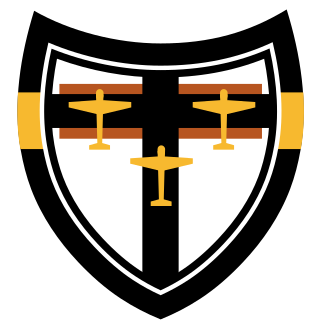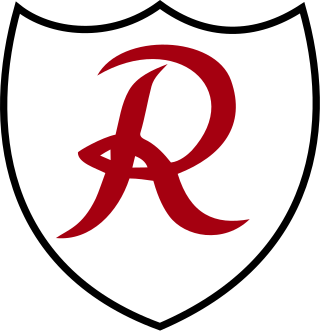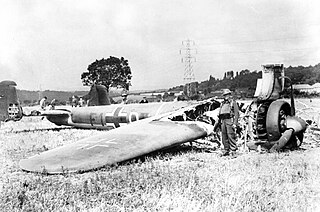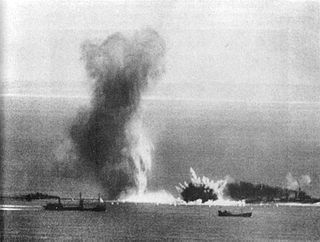
Operation Sea Lion, also written as Operation Sealion, was Nazi Germany's code name for their planned invasion of the United Kingdom. It was to take place during the Battle of Britain, nine months after the start of the Second World War. Following the Battle of France and that country's capitulation, Adolf Hitler, the German Führer and Supreme Commander of the Armed Forces, hoped the British government would accept his offer to end the state of war between the two. He considered invasion to be a last resort, to be used only if all other options had failed.

The Battle of Britain was a military campaign of the Second World War, in which the Royal Air Force (RAF) and the Fleet Air Arm (FAA) of the Royal Navy defended the United Kingdom (UK) against large-scale attacks by Nazi Germany's air force, the Luftwaffe. It was the first major military campaign fought entirely by air forces. The British officially recognise the battle's duration as being from 10 July until 31 October 1940, which overlaps the period of large-scale night attacks known as the Blitz, that lasted from 7 September 1940 to 11 May 1941. German historians do not follow this subdivision and regard the battle as a single campaign lasting from July 1940 to May 1941, including the Blitz.

The Blitz was a German bombing campaign against the United Kingdom, in 1940 and 1941, during the Second World War. The term was first used by the British press and originated from the term Blitzkrieg, the German word meaning 'lightning war'.

Adolf Josef Ferdinand Galland was a German Luftwaffe general and flying ace who served throughout the Second World War in Europe. He flew 705 combat missions and fought on the Western Front and in the Defence of the Reich. On four occasions, he survived being shot down, and he was credited with 104 aerial victories, all of them against the Western Allies.

Wilhelm Hugo Sperrle, also known as Hugo Sperrle, was a German military aviator in World War I and a Generalfeldmarschall in the Luftwaffe during World War II.

The Pointblank directive authorised the initiation of Operation Pointblank, the code name for the part of the Allied Combined Bomber Offensive intended to cripple or destroy the German aircraft fighter strength, thus drawing it away from frontline operations and ensuring it would not be an obstacle to the invasion of Northwest Europe. The Pointblank directive of 14 June 1943 ordered RAF Bomber Command and the U.S. Eighth Air Force to bomb specific targets such as aircraft factories, and the order was confirmed when Allied leaders met at the Quebec Conference in August 1943. Up to that point, the RAF and USAAF had mostly been attacking the German industry in their own way – the British by broad night attacks on industrial areas, and the US in "precision attacks" by day on specific targets. The operational execution of the Directive was left to the commanders of the forces. As such, even after the directive, the British continued their night attacks. The majority of the attacks on German fighter production and combat with the fighters were conducted by the USAAF.

Jagdgeschwader 27 (JG 27) "Afrika" was a fighter wing of the Luftwaffe during World War II. The wing was given the name "Africa" for serving in the North African Campaign predominantly alone in the period from April 1941 to September 1942. Elements of JG 27 fought in every major theatre of operations in which the Wehrmacht operated.

Jagdgeschwader 2 (JG 2) "Richthofen" was a German fighter wing during World War II. JG 2 operated the Messerschmitt Bf 109 and Focke-Wulf Fw 190 single-seat, single-engine interceptor aircraft.

Jagdgeschwader 26 (JG 26) Schlageter was a German fighter-wing of World War II. It was named after Albert Leo Schlageter, a World War I veteran, Freikorps member, and posthumous Nazi martyr, arrested and executed by the French for sabotage in 1923. The wing fought predominantly against the Western Allies.

Adlertag was the first day of Unternehmen Adlerangriff, an air operation by Nazi Germany's Luftwaffe intended to destroy the British Royal Air Force (RAF). The operation came during the Battle of Britain after Britain rejected all overtures for a negotiated peace with Germany. However, Adlertag and subsequent operations failed to destroy the RAF or gain local air superiority.

Hans Jeschonnek was a German military aviator in the Luftstreitkräfte during World War I, a general staff officer in the Reichswehr in the inter–war period and Generaloberst (Colonel-General) and a Chief of the General Staff in the Luftwaffe, the aerial warfare branch of the Wehrmacht during World War II.

The Defence of the Reich is the name given to the strategic defensive aerial campaign fought by the Luftwaffe of Nazi Germany over German-occupied Europe and Germany during World War II. Its aim was to prevent the destruction of German civilians, military and civil industries by the Western Allies. The day and night air battles over Germany during the war involved thousands of aircraft, units and aerial engagements to counter the Allied strategic bombing campaign. The campaign was one of the longest in the history of aerial warfare and with the Battle of the Atlantic and the Allied Blockade of Germany was the longest of the war. The Luftwaffe fighter force defended the airspace of German-occupied territory against attack, first by RAF Bomber Command and then against the United States Army Air Forces (USAAF) in the Combined Bomber Offensive.

Kampfgeschwader 3 "Blitz" (KG 3) was a Luftwaffe bomber wing during World War II.

Battle of Britain Day, 15 September 1940, is the day on which a large-scale aerial battle in the Battle of Britain took place.
During the Second World War the German Luftwaffe was the main support weapon of the German Army (Heer). It fought and supported the Wehrmacht's war effort throughout the six years of conflict and contributed to much of Nazi Germany's early successes in 1939–1942. After the turn in Germany's fortunes, it continued to support the German ground forces until the German surrender in May 1945.
Zerstörergeschwader 76 was a Zerstörergeschwader (wing) of the German Luftwaffe during World War II. The wing operated the Messerschmitt Bf 109 in the early phases of World War II, then the Messerschmitt Bf 110 for the duration of the war.

Kampfgeschwader 2Holzhammer was a Luftwaffe bomber unit during the Second World War. The unit was formed in May 1939. The unit operated the Dornier Do 17 light bomber, Dornier Do 217 and Junkers Ju 188 heavy bombers. During the course of the Second World War KG 2 lost 767 aircraft destroyed and 158 damaged. According to H.L. de Zeng at al, it suffered 1,908 personnel killed in action or missing in action and 214 as prisoners of war. Broken down further, for the duration of the war KG 2 lost 1,228 killed, 688 missing, 656 wounded and with 214 captured, for a total of 2,786 in both combat and non-combat operations.

The Hardest Day was a Second World War air battle fought on 18 August 1940 during the Battle of Britain between the German Luftwaffe and British Royal Air Force (RAF). On that day, the Luftwaffe made an all-out effort to destroy RAF Fighter Command. The air battles that took place on that day were amongst the largest aerial engagements in history to that time. Both sides suffered heavy losses. In the air, the British shot down twice as many Luftwaffe aircraft as they lost. However, many RAF aircraft were destroyed on the ground, equalising the total losses of both sides. Further large and costly aerial battles took place after 18 August, but both sides lost more aircraft combined on this day than at any other point during the campaign, including 15 September, the Battle of Britain Day, generally considered the climax of the fighting. For this reason, Sunday 18 August 1940 became known as "the Hardest Day" in Britain.

The Kanalkampf was the German term for air operations by the Luftwaffe against the Royal Air Force (RAF) over the English Channel in July 1940, beginning the Battle of Britain during the Second World War. By 25 June, the Allies had been defeated in Western Europe and Scandinavia. Britain had rejected peace overtures and on 16 July, Adolf Hitler issued Directive 16 to the Wehrmacht, ordering preparations for an invasion of Britain, under the codename Unternehmen Seelöwe.
Zerstörergeschwader 2 was a Luftwaffe heavy/destroyer Fighter Aircraft-wing of World War II.
















